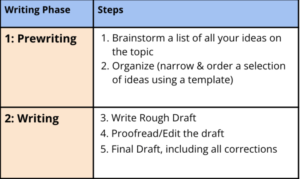Writing: A Complex Language Task
Writing is an incredibly complex language task. For everyone! The human brain is wired for listening and speaking, but the fact of the matter is that we haven’t been reading or writing for long enough for our brains to develop intrinsic strategies to naturally tackle those domains of language. We have to be explicitly taught how to read and write, and our brains are then (often) able to say, “ohhhh! Ok, I’ve got this now” and eventually develop automaticity in those areas. It is for this very reason that our earliest years in school focus first, primarily, on learning how to read, and then after and alongside that, ideally, how to write. For some reason, however, the writing piece often gets lost or abandoned once it’s assumed that a student can read. For students with language-based learning disabilities topped by weaknesses in executive function, this can cause some major problems.
Using 5-Step Writing Process
At Landmark, teachers help students develop written language skills through a consistent, research-based, multi-step writing process that occurs in two distinct phases: the prewriting phase (brainstorm, organize), which is all about generating and organizing ideas, and the writing phase (rough draft, edit/proofread, final draft), which tasks students to take all of those ideas they’ve generated and formulate them into full sentences and paragraphs, paying attention to grammar, mechanics, and content.
 Why all the steps, one might ask? First and foremost, our goal is to support the language needs of students with language-based learning disabilities. However, there is a secondary benefit. By breaking down the overwhelming, often nebulous, and always time-consuming task of writing something into smaller, more manageable steps, we’re building in a support system for students’ executive function needs.
Why all the steps, one might ask? First and foremost, our goal is to support the language needs of students with language-based learning disabilities. However, there is a secondary benefit. By breaking down the overwhelming, often nebulous, and always time-consuming task of writing something into smaller, more manageable steps, we’re building in a support system for students’ executive function needs.
What is Executive Function, Again?
A former Landmark Outreach colleague, Patricia Newhall, defines executive function as “the brain’s ability to coordinate the cognitive and psychological processes needed to initiate, sustain, monitor and adapt the behaviors and attitudes required to achieve a goal” in her book Language-Based Teaching Series: Executive Function Foundations for Learning and Teaching (2014). Basically, it’s our brain’s ability to coordinate our thinking and our emotions in order to get things done. Dr. Thomas E. Brown offers an excellent analogy comparing our executive function to the conductor of an orchestra. In a 2007 publication of Educational Leadership Brown writes, “regardless of their expertise, the musicians need a competent conductor who will select the piece to play, make sure they start playing at the same time and stay on tempo, fade in the strings and then bring in the brass, and manage them as they interpret the music. Without an effective conductor, the symphony will not produce good music” (p. 23). At Landmark, students are explicitly taught and encouraged to implement specific study skills strategies to support executive function across content areas, including when we’re engaging in written work. There are multiple ways you can support a student with weak executive function as they navigate their way through a multi-step writing process. Here are just a few:
Materials Management:
- Show students a model writing workspace (this could be a picture on the wall, or an actual physical model they can reference in the classroom).
- Develop and maintain a consistent filing system, like a master binder. For digital materials, create a class folder with sub-sections that mirror the physical class binder.
- Directly cue students to store the materials generated in each phase of the writing process in the appropriate section of their class filing system (physical and/or digital). Continue to cue until students develop automaticity in this area.
- Develop a “writing portfolio” with students as a way to organize, showcase and reflect upon their written work. If possible, this should be managed by students. Create a twin “teacher portfolio” in which you keep copies of student work for data tracking.
Time Management:
- Write and actively engage with a class agenda, including each broken down step of the writing process that you plan to address that day.
- Incorporate routines that help students to “see” and “feel” time (calendars, planners, etc.).
- Incorporate strategies which task students to envision their final product, then break down the steps they need to take in order to achieve that goal. Incorporate metacognitive questioning into the task: What mindset will you need to have in order to do it? What obstacles might get in your way? How will you feel when you are done?
- Incorporate regular check-ins with students to see whether their plan is “going to plan.”
Language and Information Management:
- Develop consistent “norms” for language management within the classroom. Students should expect that all assignments will be paired with a set of corresponding visual supports (optional, required, and/or differentiated).
- Provide students with graphic organizers and templates that correspond to the content requirements of the writing task, and model their use.
- Provide a visual to cue students on the correct “shape” of the assigned writing task.
- Provide models for each step of the writing process, particularly the final draft.
References
- Brown, T.E. (2007). A New Approach to Attention Deficit Disorder. Educational Leadership 64, 22-27.
- Newhall, P. W. (2014). Executive Function: Foundations for Learning and Teaching. In P.W. Newhall (Ed.), Language-Based Teaching Series. Prides Crossing, MA: Landmark School Outreach Program.



